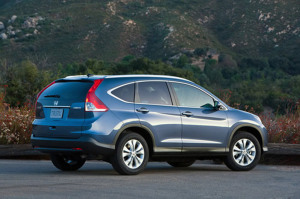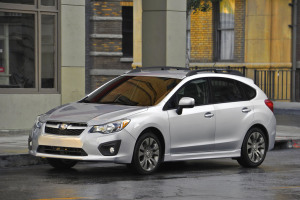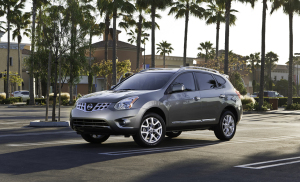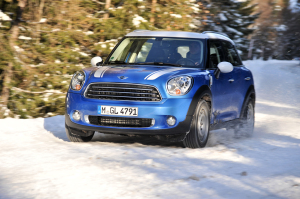Over the last week, Melissa and I have started the process of choosing a replacement for our venerable 2006 Honda Civic. The Civic is ostensibly ‘Melissa’s’ car, even though I do something like ninety percent of the family driving no matter which car we’re using, so Melissa is the primary driving force in choosing what the replacement will be (though I have a veto authority). From a long list of sedans, wagons, and crossovers, she narrowed it down to four possible vehicles and we’ve test-driven each of them over the last week.
In typical Melissa form, the list isn’t particularly logical. It includes two true crossovers, a compact wagon, and a . . . Mini Countryman, which really doesn’t fit in either category. The four vehicles were the Honda CR-V crossover, the Subaru Impreza 5-door wagon, the Nissan Rogue crossover, and the aforementioned Countryman. Here’s a brief review of how they stacked up.
Honda CR-V

Our first test drive was Honda’s well-regarded CR-V crossover, which we test-drove in the LX-AWD trim level at Honda of Dulles. The CR-V is based on the same chassis as the Civic compact, which has seen little serious change since our 2006 model was manufactured. As such, the driving feel of the larger crossover was quite similar to that of our Civic. Of course, the seating position is higher off the ground, and Honda has also made the steering a bit less ‘touchy’ than that in the Civic.
There’s a lot to like about the CR-V. It looks pretty good; even the ‘base’ LX trim is quite well equipped and can be fitted with Bluetooth connectivity, iPod and generic MP3 player support, and a rear-view camera; it’s spacious and comfortable for rear-seat passengers; and there’s ton of cargo space; the center console is spacious and functional. More importantly, the ride at city and highway speeds is smooth and comfortable. The controls feel very natural and it handles competently.
The cleverly-designed rear seats fold down nearly-flat with nothing more than a pull of a fabric loop on the sides of the seats, or side-mounted levers in the back. In other words, you can fold the seats down quickly and easily whether you’re at the rear passenger doors or the lift-gate when you realize you need to. But although the CR-V is a nice vehicle all-around, seeing these smartly-designed seats in action was the only time I found myself really grinning at it. Otherwise, it is unassuming and uninteresting.
Being unassuming and uninteresting is not necessarily a bad thing. My Subaru Outback is unassuming and uninteresting, but it’s a fine workhorse and I’ve really come to love it . . . not because it’s very special, powerful, clever, or attractive, but merely because it does its job really, really well. No hassles. No trouble. No glitz and glamour. But there were a couple of things about the CR-V that troubled me.
First, the gauge cluster looks like it’s trying to be glitzy and glamorous in a car that . . . isn’t. The photos on Honda’s web site don’t do it justice. The centered speedometer is arranged in some kind of 3D arrangement where it seems to float ‘above’ the rest of the cluster. Some might interpret this as attention to detail, but it struck me as a little bit of ‘trying too hard.’ Worse, after I positioned myself in the driver’s seat, adjusted its position and the position of the steering wheel to me liking, and took stock of my surroundings, I found that my right knee was perilously close to the dash panel—less than an inch away.
The design of the dash, which swoops down toward the center-mounted gear shift, is a damning example of form over function. It made me feel a bit cramped, which should never happen in a crossover . . . especially not one derived from the comfortable and surprisingly spacious Civic.
Subaru Impreza

Our next stop was Stohlman Subaru in Herndon, the dealership where we bought my aforementioned Outback, to test drive an Impreza 5-door compact. Unfortunately though, there weren’t any available on the lot. Supply of Imprezas is quite limited, in part because the newly-designed model is in high demand, and in part because Subaru has earmarked too many of them for the Japanese domestic market, where sales are through-the-roof.
They did, however, have a 4-door sedan version of the Impreza available in the 2.0i trim, which is essentially the same car with less cargo space. It gave us a very close analog to test drive.
Like all Subarus in the U.S. market (except for the upcoming BRZ sports car), the Impreza comes standard with the Subaru symmetric all-wheel-drive system and their smooth boxer (horizontally opposed) engine. The newly-redesigned Impreza is bigger than its predecessor, yet thanks to its continuously variable transmission (CVT) and other technical improvements it gets drastically better fuel economy (25 mpg city, 33 highway—impressive for an AWD vehicle).
But that fuel economy comes at a cost. For a compact sedan going head-to-head with the Honda Civic, with which I am obviously quite familiar, the Impreza’s acceleration performance was downright disappointing. The car did perfectly fine in gentle city driving, but when I put the pedal on the floor it seemed to take a good 2 or 3 seconds before the on-board computers controlling the throttle and transmission decided to actually give me the power I was asking for. Once it all kicked-in the acceleration was acceptable, but it took far, far too long to deliver.
This was my first time driving a car with a CVT, and it wasn’t nearly as disconcerting as I had expected it to be. Traditional automatic transmissions available today typically have 4, 5, or 6 gears, and we are all familiar with the distinctive shift points as you accelerate. CVT’s don’t shift this way, but instead continually adjust the gearing as you drive. Your revs stay about the same under acceleration. The only time it really ‘felt’ different than a normal transmission was under hard acceleration. In normal driving it seemed perfectly normal, and I didn’t notice that the shifting wasn’t happening unless I happened to be thinking about it. The Impreza also has a ‘sport mode’ that emulates a sequential clutch-less manual by skipping the CVT to defined shift points.
Other than the depressingly pokey acceleration, the Impreza is a great car. Although we weren’t able to see a 5-door wagon in person, I expect that it has cargo capacity comparable to other compact wagons like the Mazda 3 and Hyundai Elantra Touring. It has a comfortable, utilitarian cockpit with simple, straightforward controls. The rear seats were sufficiently spacious for a compact, and Subaru’s unique pairing of the boxer engine and symmetric AWD system simply can’t be beat—especially not in the compact class, where it is basically the only AWD vehicle available. It handles well and rides comfortably.
Nissan Rogue

Our next stop was Brown’s Sterling Nissan to try out a Rogue crossover in the SV-AWD trim. The Rogue is Nissan’s compact crossover, and is based on the same chassis as the Sentra compact sedan (much like Honda’s CR-V is based on the Civic chassis).
Right away, the Rogue stood apart from its CR-V competitor. It’s perhaps a bit less attractive to look at, and the interior makes none of Honda’s efforts at cleverness and glitz. Like the Impreza (or my beloved Outback), the Rogue is direct and to-the-point. The gauge cluster is simple and clear. The rear seats don’t have Honda’s cleverness, but they fold down nearly-flat just the same. It just does its job, and does it well.
Like the other cars we test-drove, the Rogue comes (in the SV trim, at least) with MP3 player integration (including iPod) and Bluetooth hands-free connectivity. Like the CR-V, it also has a rear-view camera that activates automatically when you put it in reverse. The Rogue could be put into ‘sport mode,’ which tightens it up and makes it more . . . um . . . sporty. Frankly, I didn’t really notice much difference. It also has an AWD lock, an important feature in heavy snow and other tight-spots which most modern crossovers (and all Subarus) lack.
As a driver, I found the Rogue very comfortable. Steering, braking, and acceleration were all very natural and direct. It had none of the CR-V’s ergonomic problems, and was surprisingly composed on the road. It didn’t have the ‘wallowing’ feel I’ve come to expect from most crossovers and SUV’s. Like the CR-V it’s probably a bit on the unassuming and uninteresting side, but it also strikes me as a car much like my Outback: one that will just do its job, and do it really, really well. It feels simple and solid, even with all the gizmos and gadgets nestled within.
As I drove the Rogue, I struggled to find anything wrong with it. My only immediate criticism was that, as I mentioned earlier, the sport mode didn’t really seem to do much . . . although it could just be that I didn’t experiment with it enough. And any notion that the Impreza’s poor acceleration was due to its CVT went out the window on the Rouge’s test drive; the Rouge, which also has a CVT, performed admirably for a 4-cylinder crossover when I put the pedal on the floor, and had no trouble keeping up with freeway traffic.
As we pulled out of the Nissan dealership parking lot, the Rogue was clearly in the lead. It handily beat the Impreza on performance, and was better than the CR-V on ergonomics and . . . lack of misguided flair. But we still had one more test-drive ahead of us.
Mini Countryman

For our last test-drive, we took out a Mini Countryman S from BMW/Mini of Sterling. The Countryman is the largest vehicle available under the Mini marquee, and the only one with four doors and usable back seats (with enough legroom for humans, which can also fold down to provide a reasonably-sized cargo space). We test drove one in the ‘S’ trim, which is the model with a turbo and more horsepower than the base model. The one we tried had the ‘default’ two bucket seats in the back, but there is a ‘normal’ 3-person bench seat available as a no-cost upgrade.
Modern BMW-produced Minis are known as drivers’ cars, and I can see why. Some have criticized the Countryman for losing some of Mini’s distinct ‘go-cart’ drivability, but compared to all the other cars we test drove the Countryman excelled in performance and fun.
When you press on the gas, the car really goes. When you put it into ‘sport’ mode, it goes even more. It was tight and composed in the corners and held the road beautifully. You can also switch into a sequential manual shift mode (similar to that in the Impreza), which can be controlled using the gear shift knob or steering wheel-mounted paddle shifters. I played around with the paddle shifters some, but found using the shift knob disconcerting. Oh, it worked fine, but it’s backwards. You push up to downshift, and down to upshift—completely revered from the arrangement in my Outback, for which I’ve developed a reliable muscle memory.
I found the center-mounted (and over-sized) speedometer fairly useless, since the speed is displayed digitally inside the tachometer that’s mounted right in front of the driver. I didn’t find myself using the ‘real’ speedometer at all. I also didn’t much like the turn signal wand, which didn’t actually ‘stick’ into position when the turn signal was on. It still worked the same as a regular turn signal wand, but it felt like it wasn’t working even though it was. I figure I’d get used to it with time. In fact, this same basic complaint can be repeated for most of the toggles and controls: few of them are in their industry-standard locations, and even those that are often don’t work quite in the industry-standard ways. The Countryman also requires premium gas, which is very annoying.
But so what? It is so darn fun to drive. If we end up with a Countryman, I’m sure we’ll get used to Mini’s unique placement and functionality of the switches and toggles, and having to use premium gas will probably only cost us between $100 and $150/year, which isn’t too bad. But we’ll always appreciate the way it drives—and it does drive superbly. The bigger concern for us is the fact that many of the things that our test-drive Countryman had—Bluetooth functionality, iPod connectivity, moonroof, etc.—were actually expensive add-ons. Although the Countryman starts at a perfectly reasonable price, comparable with the other cars we tested, once you add all the ‘must have’ features you end up paying a lot more than you do for its competitors.
But it might just be worth it, since the Countryman is the only car we tested that seems like it’ll really make driving fun, and yet does not completely sacrifice practicality like most of its Mini-branded brethren.
Conclusion
When all is said and done, there are two clear winners. In terms of practicality—cargo space, passenger space, fuel economy, reliability, and flexibility averaged out with one another—the Nissan Rogue is the clear winner. But when it comes to fun and excitement—performance, handling, power, and quirky uniqueness—the Mini Countryman comes out far ahead. For better or worse, Melissa seems to be leaning very strongly in the direction of fun and excitement, and this will (like the Civic) be her car . . . at least on paper, since I’ll probably still be doing most of the driving.
I’m admittedly not completely sold, especially given that specifying a Countryman with all wheel drive, Bluetooth functionality, iPod connectivity, a center console/armrest (which is an add-on, if you can believe it), and other important features pushes the price up to the $30,000 ballpark—several thousand more than the other cars we have been considering. In addition, the Countryman is unique among the cars on our list in that it requires more expensive premium gas. But, on the flip side, the Mini comes with a better standard warranty (four years instead of three) and free regular maintenance for three years. This will mitigate (but probably not completely offset) the increased fuel costs. As always, it’s a matter of trade-offs.
As to when we’ll be buying, well, we’ll see. Probably some time in the next few months, depending on how quickly we can get the finances in order. Stay tuned.

